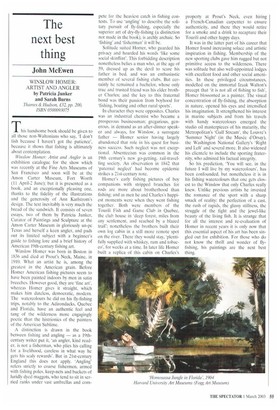The next best thing
John McEwen
WINSLOW HOMER: ARTIST AND ANGLER by Patricia Junker and Sarah Burns Thames & Hudson, £32, pp. 200, ISBN 0500093075 This handsome book should be given to all those non-Waltonians who say, 'I don't fish because I haven't got the patience', because it shows that fishing is ultimately about contemplation.
14,-"inslow Homer: Artist and Angler is an exhibition catalogue for the show which was recently at the Fine Arts Museums of San Francisco and soon will be at the Amon Carter Museum, Fort Worth (11 April-2 June); but it is presented as a book, and an exceptionally pleasing one, thanks to the fidelity of the illustrations and the generosity of Ann Karlstrom's design. The text inevitably is very much the bread of the sandwich, It consists of seven essays, two of them by Patricia Junker, Curator of Paintings and Sculpture at the Amon Carter Museum in gloriously un-pc Texas and herself a keen angler, and pads out its limited subject with a beginner's guide to fishing lore and a brief history of American 19th-century fishing art.
Winslow Homer was born in Boston in 1836 and died at Prout's Neck, Maine, in 1910. What an artist he is, among the greatest in the American grain. Before Homer American fishing pictures seem to have been painted indoors by men in satin breeches. However good, they are 'fine art', whereas Homer gives it straight, which makes him dateless, democratic, modern. The watercolours he did on his fly-fishing trips, notably to the Adirondacks, Quebec and Florida, have an authentic feel and tang of the wilderness more engagingly poetic than the histrionics of the painters of the American Sublime.
A distinction is drawn in the book between fishing and angling — as a 19thcentury writer put it, 'an angler, kind reader, is not a fisherman, who plies his calling for a livelihood, careless in what way he gets his scaly rewards', But in 21st-century England this does not apply. 'Angling' refers strictly to coarse fishermen, armed with fishing poles, keep-nets and buckets of luridly dyed maggots, who tend to sit in serried ranks under vast umbrellas and corn
pete for the heaviest catch in fishing contests. To use 'angling' to describe the solitary pursuit of fly-fishing, especially the superior art of dry-fly-fishing (a distinction not made in the book), is archly archaic. So 'fishing' and 'fisherman' it will be.
Solitude suited Homer, who guarded his privacy and hoarded his words 'like some social skinflint'. This forbidding description nonetheless belies a man who, at the age of 59, dressed up as the devil to scare his father in bed, and was an enthusiastic member of several fishing clubs. But certainly he remained a bachelor, whose only true and trusted friend was his elder brother Charles; and the key to this fraternal bond was their passion from boyhood for 'fishing, boating and other rural sports'.
In character they were opposites. Charles was an industrial chemist who became a prosperous businessman: gregarious, generous, in demand as an after-dinner speaker and always, for Winslow, a surrogate father — Homer senior having largely abandoned that role in his quest for business success. Such neglect was not exceptional. Absenteeism was common in the 19th century's new go-getting, rail-travelling society. An observation in 1842 that 'paternal neglect' had become epidemic strikes a 21st-centurynote.
Homer's early fishing pictures of boy companions with stripped branches for rods are more about brotherhood than fishing; and as men he and Charles's happiest moments were when they went fishing together. Both were members of the Tourili Fish and Game Club in Quebec, the club house in 'deep forest, miles from any settlement, and reached by a blazed trail'; nonetheless the brothers built their own log cabin in a still more remote spot on the river. There they would stay, 'plentifully supplied with whiskey, rum and tobacco', for weeks at a time. In later life Homer built a replica of this cabin on Charles's
property at Prout's Neck, even hiring a French-Canadian carpenter to ensure authenticity, and there they would retire for a smoke and a drink to recapture their Tourili and other happy days.
It was in the latter part of his career that Homer found increasing solace and artistic inspiration in fishing. Membership of the new sporting clubs gave him rugged but not primitive access to the wilderness. There was solitude but also well-appointed lodges with excellent food and other social amenities. In these privileged circumstances, modelled on the immortal Izaak Walton's precept that 'it is not all of fishing to fish', Homer blossomed as a painter. The visual concentration of fly-fishing, the absorption in nature, opened his eyes and intensified his imagination. It strengthened his interest in marine subjects and from his travels with handy watercolours emerged the studio oil masterpieces of his maturity, the Metropolitan's 'Gulf Stream', the Louvre's 'Summer Night' (in the Musee d'Orsay), the Washington National Gallery's 'Right and Left' and several more. It also widened his clientele to include the sporting fraternity, who admired his factual integrity.
So his prediction, 'You will see, in the future I will live by my watercolours', has been confounded, but nonetheless it is in his fishing watercolours that one gets closest to the Winslow that only Charles really knew. Unlike previous artists he invested the romance of the sport with a sharp smack of reality: the perfection of a cast, the rush of rapids, the glassy stillness, the struggle of the fight and the jewel-like beauty of the living fish. It is strange that for all the interest and re-evaluation of Homer in recent years it is only now that this essential aspect of his art has been singled out for exhibition. For those who do not know the thrill and wonder of flyfishing, his paintings are the next best thing,


















































































 Previous page
Previous page